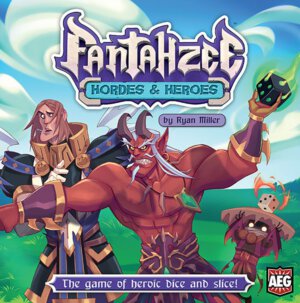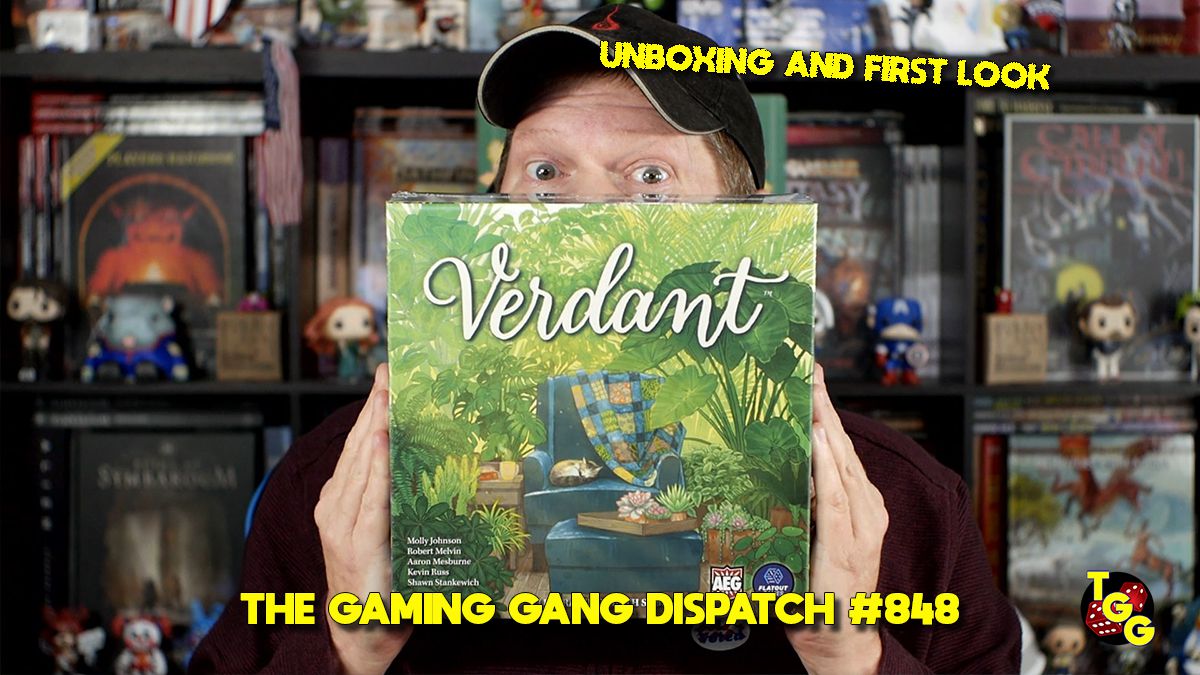
Publisher: AEG
Designer: Ryan Miller
Artist: J. Hause
Year: 2016
Genre: Card based/push your luck dice game of monster bashing
Players: Two to five players
Ages: 14+ (12+ in my opinion)
Playing Time: Around 20 – 40 minutes
MSRP: $39.99
TGG Outside the Box
Essentially Fantahzee is a touch of a fantasy take on the dice game Yahtzee. Obviously, not coming as much of a shock there considering the game’s title. Two to five players aim to defend the town of Devil’s Burden from an onslaught of monstrous armies and be declared the best leader at the end. To do so each player will need to recruit heroes, perform actions, bash baddies, snag treasure, all while hoping the dice gods are kind. Keep in mind, although everyone is looking to save the town, this isn’t a cooperative game as each player’s turn is self-contained and you can’t assist anyone else.
Upon opening the box, one is struck by the graphic design and art style of Fantahzee. I really like the look as it has a very unique fantasy/steampunkish cartoon vibe to it all. The cards are laid out and presented well, the box is structured to separate the cards nicely, and there’s even a fabric bag to hold the dice. The rulebook itself is chock full of illustrations and solid examples of play. I’ll mention you’ll want to give the twenty eight pages a thorough read through as some of rules can be a bit tricky the first time out. All in all another gold star for AEG on production quality.
Fantahzee is all about cards and dice. You’ll have card decks broken down into actions and heroes, town, and treasure cards as well as stacks of monsters and bosses (known as the Hordes). Creating the horde stacks takes a few minutes as each twelve card stack is constructed a certain way: each with a boss, five level two monsters, and six level one monsters. The first six cards of each stack is always made up of the easier baddies with the rest randomly shuffled.

Action Phase – You may recruit two heroes and perform two actions. You can only have a total of five heroes in play at one time but you can replace any already on the table with one from your hand by simply discarding the active hero. Actions can give heroes temporary abilities or allow you to manipulate the horde stacks. Also keep in mind there’s a difference between a recruited hero and active hero; recruited heroes are simply in front of you waiting to be activated in the next phase.
Dice Phase – In order to use your heroes you have to activate them and that’s where the dice come into play. The more powerful the hero the more difficult it will be to activate them. This is where that Yahtzee aspect comes to bear as you look to see just what you need to roll with your five dice to get your best heroes into battle. This could be anything from a pair to five of a kind to a straight. You get three rolls and you can keep any previously rolled dice if you’d like or change your mind as you go. Some heroes also provide special attacks or effects, extra dice, extra rolls, or even make it easier to activate other heroes.
Once you’ve activated your heroes and resolved any hero special abilities then you’ll move on to attacking the horde stacks. The game begins with the top monster of each stack revealed so you have a good idea where to begin your attacks. Each hero and monster has a strength value indicated on their cards. You’ll combine the strength of your activated heroes and look to equal, or better, the monster (or boss) you attack. If you do match or exceed your opponent’s strength then you’ve defeated the monster and, if you have any remaining strength, can attack another monster from any of the other stacks regardless if they are face up or down. If you flip up a monster you can’t defeat then your attacks immediately end.
Next, you’ll take the cards of the monsters you’ve bested and look to see if they have a counter attack value. If so, you’ll total that up, while deducting any shield icons the heroes may have, and then apply that damage to the heroes. You must discard an active hero and then subtract that hero’s strength from the total. If there’s still damage left over then you’ll need to discard another hero and so on until no damage remains.
Once you’ve dealt with the counter attacks you can then see if your remaining heroes score some treasure. Monsters may have a treasure icon (level one or two) on their card and, if they do, you’ll get to draw treasure cards equal to the number of monsters who had the icons. Each treasure card shows two options, level one and level two, and the defeated monster will indicate what level treasure you receive.
You may then assign that treasure to an active hero. Heroes may only carry one treasure at a time, although you may discard an old treasure for a new one. The loot you score can only be assigned to active heroes and you’re out of luck if you don’t have any felt active in the treasure phase; you simply don’t draw any cards.

Horde Phase – You didn’t think all these monsters are just standing around waiting for you to bash them did you? First, the rightmost horde stack is considered the vanguard and you don’t want to begin this phase with a face up monster in this stack. If the vanguard is showing a face up monster then one of the areas of town has been destroyed and you’ll have to draw a town card. This card may saddle you with a negative victory point value and could include something even worse, say needing to discard a treasure or moving a horde stacks around.
Following the vanguard attack you’ll look to see if any face up monsters have an ambush ability. If so, total these values up and apply this just as you would counter attack damage; discarding a Hero, subtracting strength, and so on.
It’s entirely possible for you to have no remaining active heroes following the Dice and Horde phases.
End Phase – Draw four cards and add them to your hand. You can only ever have five cards in your hand so, if you go over, discard down to five. Then remove the dice from your active heroes and let the next player take their turn. If the hero deck runs out of cards you’ll shuffle the discards to start a fresh deck.
The players will rinse and repeat these turns until they’ve defeated three boss monsters and then the players will total the VPs from their victory stacks – while including any negative modifiers from town cards – to determine the winner. There are also some tie breaking procedures as well to determine who comes out on top if more than one player have the highest score.
When it’s all said and done I found Fantahzee to be a fun, yet somewhat flawed, experience.

That said, on the other hand, I had some issues with Fantahzee. Strangely enough, the fact the players can’t lose slightly irked me. Yes… I understand this is a light game which isn’t aimed at serious strategy gamers or the like. Yet, I think it’s a bit silly the monster vanguard can destroy parts of Devil’s Burden – in fact what seems to be the entire town – but once those town cards are gone nothing happens; you simply don’t conduct vanguard attacks or draw town cards anymore. Personally, I think the game should end if you run out of town cards. You could still tally up the VPs and declare a winner, although it might boil down to a pyrrhic victory in the end. This could also help the game from dragging on too long, which can be a problem too as you’ll see below.
I also found the sheer amount of luck involved can turn out to be a drag. If you don’t draw good cards and/or get solid die rolls there’s no way you’ll be able to compete. I hate that Fantahzee can become a real slog if all you’re getting are wimpy heroes and watching your dice run cold; I’m all for randomness and chaos in many of my games but with this title I found things can become very unbalanced between the players rather quickly and it isn’t as if you have a lot of strategic options. Add to this the fact if everyone is getting poor dice results it can take far longer than the expected twenty to forty minutes for the game to play out.
I’m not trying to say Fantahzee is an overall bad game or try to dissuade anyone from picking it up. In all honesty, I had a great time playing with my niece and nephew (ages eleven and fifteen) as this is a title squarely aimed at family gamers like them. It just didn’t fly as well with older, more established gamers I played with later on since the game is pretty much a seat of your pants affair. Seriously though, most hardcore strategy gamers probably wouldn’t be drawn to Fantahzee in the first place since it’s obvious from looking at the box it isn’t that sort of game. I’d say if you and your friends like games like Yahtzee, or even King of Tokyo/New York, you should at least consider giving Fantahzee a try.
[rwp-review id=”0″]


















